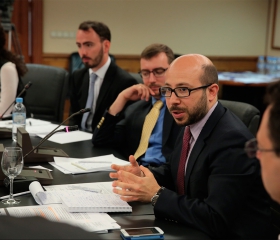
The European Union and NATO are strategic partners with their relationship expanding over more than a decade. The unique nature of this partnership lies in the fact that the EU and NATO share 22 of their member states, and five EU member states are members of NATO’s Partnership for Peace. Although the EU and NATO are organisations with different mandates, memberships and toolboxes of instruments, they promote the same principles and values – the commitment to freedom and democracy, human rights and the rule of law. With the changed security reality, brought about by instability in Europe’s Eastern and Southern neighbourhoods, the strong transatlantic relationship, including through EU-NATO relations, also remains essential and represents now more than ever one of the key elements of the partnership.
Since its inception in 2003, the EU-NATO partnership has evolved in an important way. The adoption of the Lisbon Treaty that introduced peace and security as one of the EU’s foreign policy objectives changed the attitude of the United States to the EU’s common security and defence. The return of France to NATO’s military structures, as well as the creation of the European External Action Service (EEAS), a permanent counterpart to the NATO International Staff, have all also contributed to this evolution.
A focus on pragmatism and practicality has been the main driving force of this relationship since the beginning. Apart from the long-standing cooperation in the Balkans, Afghanistan, Horn of Africa and most recently in Ukraine, the EU and NATO also cooperate on capability development, such as air-to-air refuelling and remotely piloted aircraft systems, building on their respective pooling and sharing and smart defence initiatives. On a national level, member states have one set of capabilities so better complementarity between the EU and NATO also means more efficiency and cost-effectiveness, which is crucial during times of restraining national defence budgets. The importance of investing more in defence has also been clearly underlined at the NATO Summit in Wales as well as at the December 2013 and June 2015 European Councils.
The dialogue between the two organisations has also continued to intensify over the years. EU and NATO leadership figures participate at each other’s summits and ministerial meetings. Our representatives at all levels meet on a regular basis e.g. High Representative Mogherini and NATO Secretary General Stoltenberg have met three times since taking office. Both staffs provide regular briefings to member states/allies on issues of common interest, such as maritime security, operational activities in common theatres, or cyber defence.
In the past 18 months, four EU Political and Security Committee (PSC)-NATO North Atlantic Council (NAC) meetings have been organised: One formal meeting on EUFOR Althea(1), two informal ones on Ukraine and one informal meeting on the Eastern and Southern neighbourhoods. The next informal is expected in early autumn. To put this into perspective, before the beginning of the Ukrainian crisis in 2014, the last formal PSC-NAC on EUFOR Althea took place in 2012, while an informal meeting (on Libya) happened only once in 2011.
Taking all of this into consideration it can be said that the EU and NATO have a growing relationship, acting within the available political margins and respecting the decision making autonomy of both organisations. Still, this relationship remains politically charged. Due to the political constraints and sensitivities, the formal aspects such as gathering of all member states and allies around one table and exchanging classified information, continue to face difficulties. But political constraints need political actions. Both EU and NATO officials are aware of them and are doing their utmost within the available margin of manoeuvre. However, further developments depend on the political support of all NATO allies and all EU member states.
At a time when NATO is rebalancing its core tasks towards common defence and deterrence, following the NATO Wales Summit decisions, the fact that the Common Security and Defence Policy (CSDP) is mainly outward-looking creates a significant common ground for further EU-NATO complementarity. The EU’s competitive edge lies in its comprehensive approach, a unique ability and institutional framework that allows for the strategic use of all foreign and security policy instruments, including sanctions, diplomacy, development and economic assistance.
Security and defence is inevitably going to remain high on the EU’s agenda in the coming years. That includes the nexus between internal and external security. This was clearly underlined at this year’s Foreign Affairs Council meeting in May and the European Council meeting in June which provided important guidelines for future EU efforts on security and defence. The upcoming European strategic review, led by High Representative Mogherini, should also provide further context and direction regarding the EU’s level of ambition for its Common Security and Defence Policy. The trends in the security environment in the Eastern and Southern neighbourhood, Middle East or in Africa, will have a clear impact as well.
The crises in our neighbourhood are likely to become more complex, less predictable and more susceptible to unconventional and asymmetric challenges such as hybrid and cyber warfare. CSDP has evolved significantly since its beginnings over a decade ago, deploying until now more than 30 missions and operations (with 17 active currently). Some forms of EU engagement such as training and advisory missions, institution and capacity building have become its trademarks. The interest in as well as demand for EU assistance continues to grow.
Maritime security, hybrid threats, strategic communication, cyber security as well as defence and security capacity building in Europe’s neighbourhood are among the spheres where there are natural avenues for closer EU-NATO cooperation. In all these areas both organisations have been developing their respective strategies and policies and both recognise the importance and potential for closer future cooperation. Working side-by-side but also complementing and mutually reinforcing each other’s efforts will further strengthen our engagements towards improving our security and stability. Pragmatism will continue to be the key in this respect. The challenges that both the EU and NATO are facing are the same and European security and prosperity depends on the EU and NATO working together.
(1) EU military operation in Bosnia and Herzegovina (Operation EUFOR ALTHEA)
The opinions articulated above represent the views of the author and cannot be regarded as the official position of the European External Action Service. They do not necessarily reflect the position of the European Leadership Network or any of its members. The ELN’s aim is to encourage debates that will help develop Europe’s capacity to address the pressing foreign, defence, and security challenges of our time.


